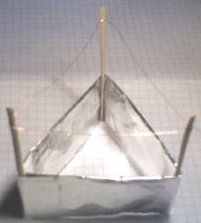Thomas Townsend Brown (March 18, 1905 – October 22, 1985) was an American physicist.
Biography
Early and middle years
Brown was born in Zanesville, Ohio; his parents were Lewis K. and Mary Townsend Brown. In 1921, Brown discovered what was later called the Biefeld-Brown effect while experimenting with a CoolidgeX-ray tube. This is a vacuum tube with two asymmetrical electrodes. Brown noticed that there was a force exerted by the tube when it was connected to a high-voltage source. This force was not caused by the X-rays, but instead was related to ionized particles created at the small (sharp) electrode and moving to the large (flatter) electrode. Later, in 1923, he collaborated with Paul Alfred Biefeld at Denison University, Granville, Ohio. He started a military career afterwards and was involved in a number of science programs.
In 1930 he joined the U.S. Navy and conducted fundamental research in electromagnetism, radiation, field physics, spectroscopy, gravity and other topics. He later worked for Glenn L. Martin and, still later, for the National Defense Research Committee (NDRC) and the Office of Scientific Research and Development, headed at that time by Dr. Vannevar Bush. After 1944 he worked as a consultant to the Lockheed-Vega Aircraft Corporation.
Later years
In 1955, Brown went to England, and then France where he worked for La Société Nationale de Construction Aéronautique du Sud Ouest (SNCASO) on secret research called Projet Montgolfier [1], a study of the Biefeld-Brown effect. In 1956, the aviation trade publication Interavia reported that Brown had made substantial progress in anti-gravity or electro-gravitic propulsion research. Top U.S. aerospace companies had also become involved in such research (see United States gravity control propulsion research (1955 - 1974)) which may have become a classified subject by 1957. Others contend Brown's research simply reached a dead end and lost support. Though the effect he discovered has been proven to exist by many others, Brown's work was controversial because others and even he himself believed that this effect could explain the existence and operation of unidentified flying objects (UFOs).
Brown was an early investigator of UFOs and in 1956 helped found the National Investigations Committee on Aerial Phenomena (NICAP). Though Townsend resigned not long after NICAP was founded, NICAP was an influential force in civilian UFO research through 1970. The organization's activities drew the attention of the Central Intelligence Agency (CIA), several high-level officers of which joined the group. Brown's research has since become something of a popular pursuit around the world, with amateur experimenters replicating his early experiments in the form of "lifters" powered by high-voltage.
References:
- Projet Montgolfier
- Patents
- GB300311 - A method of and an apparatus or machine for producing force or motion (accepted 1928-11-15)
- US 1,974,483 - "Electrostatic motor" (1934-09-25)
- US 2,949,550 - Electrokinetic apparatus (1960-08-16)
- US 3,018,394 - Electrokinetic transducer (1962-01-23)
- US 3,022,430 - Electrokinetic generator (1962-02-20)
- US 3,187,206 - "Electromagnetic apparatus" (1965-06-01)
- US 3,196,296 - Electric generator (1965-07-20)
- General information
- "UFO How-To Volume II - Electrogravitics" contains the patents of Brown, his Project Winterhaven prospectus, and other works in the field of electrokinetic / electrogravitic propulsion systems, www.ufohowto.com
- "Towards Flight without Stress or Strain...or Weight," Interavia, Vol. XI, No. 5, 1956, pp. 373-374.
- Cook, Nick, The Hunt for Zero Point, New York: Broadway Books, 2001.
- Dolan, Richard M., UFOs and the National Security State, Charlottesville, VA: Hampton Roads, 2002, pp. 174-175.
- Hansen, Terry, The Missing Times: News media complicity in the UFO cover-up, Xlibris, 2000, pp. 180-181.
- Websites
- The Legacy of T. Townsend Brown - New portal and forum Maintained by MidValley Hosting
- Official Townsend Brown Technology Site - (authorized by the Townsend Brown family). Maintained by Qualight, L.L.C.
- Maintained by Paul Schatzkin, author of "Defying Gravity: The Parallel Universe of T. Townsend Brown."
- Maintained by Luke "Lucky" Fortune, author of the encyclopedic "UFO How-To" series.
- Projet Montgolfier Reports 1955-58
- Marcus Albert Reid
- Thomas Townsend Brown, Electrogavitic propulsion inventor
- Wikipedia Related Articles






